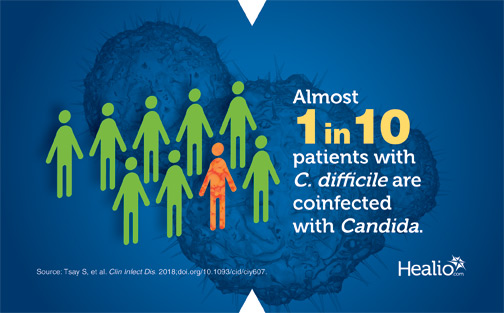Patients with candidemia have significant risk for CDI coinfection
Click Here to Manage Email Alerts

Almost 10% of patients with candidemia also had a Clostridium difficile infection coinfection, according to a recent study.
These conditions occurring concurrently can lead to prolonged hospital stays and broad-spectrum antibiotic use, according to the study.
“Nearly one in 10 patients with candidemia also had [C. difficile infection (CDI)] coinfection in this study,” Sharon V. Tsay, MD, from the CDC’s Division of Foodborne, Waterborne, and Environmental Diseases, and colleagues, wrote. “This prevalence is high and likely underappreciated by clinicians and public health personnel. The true prevalence of coinfection may in fact be higher than 9%.”
The CDC, in collaboration with state and local agencies, conducted active, population-based surveillance for candidemia through its Emerging Infections Program. The surveillance took place in 23 counties across five states from 2014 to 2016, comprising approximately 9 million people.
Researchers defined CDI-candidemia coinfection as occurring in a broad window of 90 days before or after incident candidemia for this study and reported that among the 2,026 candidemia cases surveilled, 189 had CDI coinfection. They found that most CDI cases occurred within 1 week either before or after candidemia, which supports the idea that risk factors and pathophysiology for the two infections are closely connected, they wrote.
Common underlying conditions occurring in patients treated for the coinfection were diabetes (43%), liver disease (21%), and solid organ malignancy (14%). In addition, 86% of patients had been treated with antibiotics, 78% of patients had central venous catheters in place when diagnosed with candidemia and 71% had a separate hospital stay in the preceding 90 days.
Based on these findings, researchers suggested that clinicians be more vigilant in looking for CDI in the context of candidemia. The authors wrote that when one of these infections is present in patients with certain underlying conditions, testing for other pathogens should be considered.
“Even though we did not see evidence of increased mortality among those with coinfection compared with candidemia alone in our study, having both infections adds to the complexity of illness and health care costs,” the authors wrote. “Ongoing research into the intestinal microbiome will undoubtedly contribute to better understanding of these infections in the future, and importantly, how to prevent them.” – by Caitlyn Stulpin
Disclosures: The authors report no relevant financial disclosures.

